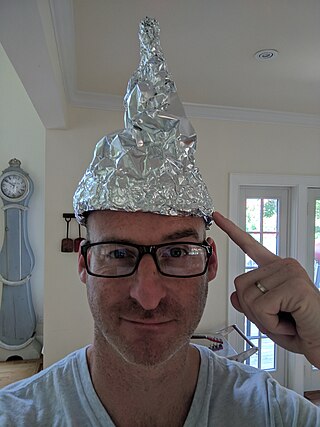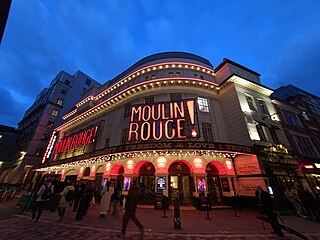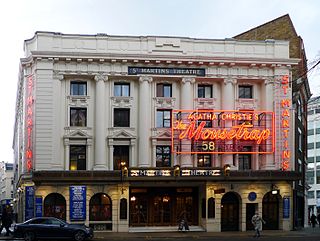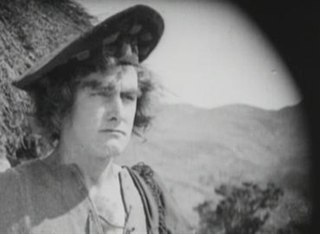
A tin foil hat is a hat made from one or more sheets of tin foil or aluminium foil, or a piece of conventional headgear lined with foil, often worn in the belief or hope that it shields the brain from threats such as electromagnetic fields, mind control, and mind reading. The notion of wearing homemade headgear for such protection has become a popular stereotype and byword for paranoia, persecutory delusions, and belief in pseudoscience and conspiracy theories.

Gillian Wearing CBE, RA is an English conceptual artist, one of the Young British Artists, and winner of the 1997 Turner Prize. In 2007 Wearing was elected as lifetime member of the Royal Academy of Arts in London. Her statue of the suffragist Millicent Fawcett, popularly known as "Hanging out the washing", stands in London's Parliament Square.

Dame Mary Louise Webster,, known professionally as May Whitty and later, for her charity work, Dame May Whitty, was an English stage and film actress. She was one of the first two women entertainers to become a Dame. The British actors' union Equity was established in her home in 1930.

Morning dress, also known as formal day dress, is the formal Western dress code for day attire, consisting chiefly of a morning coat, waistcoat, and formal trousers for men, and an appropriate gown for women. Men may also wear a popular variant, where all parts are the same colour and material, often grey, and usually called "morning suit" or "morning grey" to distinguish it; considered properly appropriate only to festive functions, such as summer weddings and horse races, which consequently makes it slightly less formal. The correct hat would be a formal top hat, or if on less spacious audience settings, optionally a collapsible equivalent opera hat.

The social season, or season, refers to the traditional annual period in the spring and summer when it is customary for members of the social elite of British society to hold balls, dinner parties and charity events. Until the First World War, it was also the appropriate time to reside in the city rather than in the country in order to attend such events.

The Arts Theatre is a theatre in Great Newport Street, in Westminster, Central London.
Clive Wearing is a British former musicologist, conductor, tenor and pianist who developed chronic anterograde and retrograde amnesia in 1985. Since then, he has lacked the ability to form new memories and cannot recall aspects of his memories, frequently believing that he has only recently awoken from a comatose state.

The Piccadilly Theatre is a West End theatre located at the junction of Denman Street and Sherwood Street, near Piccadilly Circus, in the City of Westminster, London. It opened in 1928.

St Martin's Theatre is a West End theatre which has staged the production of The Mousetrap since March 1974, making it the longest continuous run of any show in the world.

Mary Sophia Allen OBE was a British political activist known for her defence of women's rights in the 1910–1920s and later involvement with British fascism. She is chiefly noted as one of the early leaders of the Women's Police Volunteers. Allen repeatedly sought to challenge or modernise the existing systems of the time, ensuring the Women's Police Service could become an auxiliary force after women were admitted into certain British police forces. She stood once for the House of Commons as an Independent Liberal, turning over her Women's Auxiliary Service to breaking the General Strike of 1926. Thereafter she met and talked with European fascists and anti-communist brigades, entailing frequent trips abroad and publicly joining the British Union of Fascists in 1939. In retirement, Allen was an activist for animal rights.

Barbara Gott (1872–1944) was a Scottish stage and film actress. In 1913 she made her West End debut in Stanley Houghton's Trust the People.
Her First Affaire is a 1932 British drama film directed by Allan Dwan and starring Ida Lupino, George Curzon and Diana Napier. It was based on Frederick J. Jackson's 1930 version of Merrill Rogers's 1927 play Her First Affaire; a play which Jackson significantly modified for the London stage and for which he shared co-author credit in this 1930 version. It was shot at Teddington Studios, with sets designed by the art director J. Elder Wills.
Thomas Angus White was an English footballer who started his career as a centre-forward before moving to centre-half, where he played for Everton in the 1933 FA Cup final as well as making one appearance for England.

David Hawthorne was a British stage and film actor. He played the leading man in a number of films during the silent era, but later switched to character roles. One of his more notable roles was that of Rob Roy MacGregor in the 1922 film Rob Roy.

A statue of Sherlock Holmes by the sculptor John Doubleday stands near the supposed site of 221B Baker Street, the fictional detective's address in London. Unveiled on 23 September 1999, the sculpture was funded by the Abbey National building society, whose headquarters were on the purported site of the famous address. As no site was available on Baker Street itself the statue was installed outside Baker Street tube station, on Marylebone Road. Doubleday had previously produced a statue of Holmes for the town of Meiringen in Switzerland, below the Reichenbach Falls whence the detective fell to his apparent death in the 1893 story "The Final Problem".
"The Beautiful Suit" is a short story by H. G. Wells, originally published under the title "A Moonlight Fable" in the April 10, 1909, number of Collier's Weekly. Written in the manner of Hans Christian Andersen's fairy tales, the story features but two characters: an unnamed "little man", and his mother. The mother has made "a beautiful suit of clothes" for the man, who takes inordinate delight in this possession.
Emil and the Detectives is a 1935 British family adventure film directed by Milton Rosmer and starring John Williams, George Hayes and Mary Glynne.
Double Dan is a 1927 comedy crime play by the British writer Edgar Wallace. It is inspired by the 1924 novel Double Dan by Wallace. The plot concerns high finance and a criminal who is a master of disguise.
Double Dan is a 1924 crime novel by the British writer Edgar Wallace. It was published in the United States as Diana of Kara Kara.
The Terror is a 1927 mystery thriller play by the British writer Edgar Wallace. It is based on Wallace's 1926 novel The Black Abbot.












